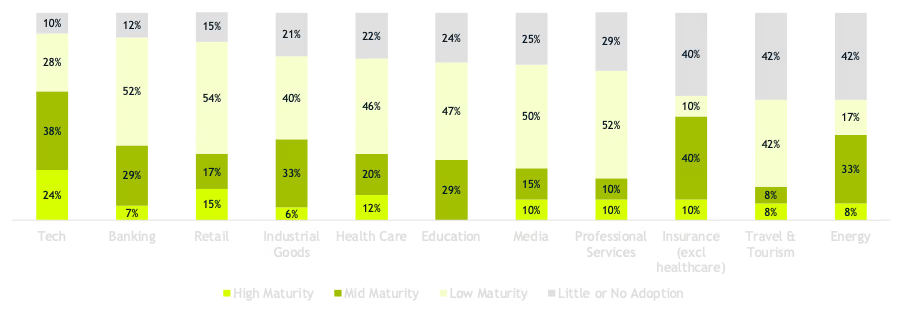Enterprise AI in 2025 – what will separate the winners from the losers?
Over the past year at Tomoro, we've noticed a significant shift in some of our clientsʼ maturity in discussing, building and deploying AI applications. A growing number are leading their industries in AI adoption and their progress is accelerating - they're starting to pull away from the pack.
This was also reflected in a recent BCG survey.
- Outside the tech sector, roughly 10-15% of organisations say they strategically deploy AI in core business areas.
- Another 50-60% are experimenting but getting stuck at the prototype or PoC stage.
- The rest have minimal to no AI adoption.

Source: BCG & GLG IT Buyer Pulse Check 7.0 (March 2024)
[https://www.bcg.com/publications/2024/it-spending-pulse-as-genai-investment-grows-other-it-projects-get-squeezed]
What is differentiating the industry leaders, and how do we see this changing through 2025?
The most mature organisations share some common characteristics that have been key to their early success with AI. Getting these right will be a strong indicator of who will come out on top in 2025 and who will lag further behind.
1. Finding the “AI gravityˮ
In our experience, organisations often go wrong by centrally funding AI experimentation from a tech budget without strong business sponsorship. This leads to successful prototypes lacking the business "pull" to overcome scaling barriers. We call this pull the “AI gravityˮ.
Where we've seen the most success, AI funding is distributed to business areas, from marketing to customer operations, to stakeholders with the influence to disrupt current practices.
AI needs to be a strategic business priority, not just a technology priority. Achieving this requires a baseline understanding of AI across the business.
2. Design for AI tomorrow, not AI today
The capabilities and economics of AI models have drastically improved over the past year and will continue to do so.
GPT-4o mini is over 60% cheaper than GPT-3.5 turbo and is much more capable. Foundational AI models today are the most expensive and "dumbest" they'll ever be.
We have helped several clients to break out of their paralysis debating costs to scale an AI proof of concept (PoC). What they often donʼt realise, even if token costs remain the same over the next 12 months, the cost of running an AI application in production can be reduced dramatically from initial prototype costs.
For example, at one client deploying a successful AI PoC for complex information extraction, we are forecasting a 53-fold reduction in processing cost per record, using optimisation strategies including:
- Switching to a cheaper fine-tuned model
- Using micro-batching
- Optimising retrieval
- Further prompt engineering.
3. A common-sense approach to AI risk
Deploying AI solutions should be routine and straightforward. The principles and risks are similar to deploying any other application. The differences arise in how decisions around technology and models are made and governed. Existing governance processes can bottleneck AI applications at the POC stage.
Organisations familiar with statistical or machine learning models might assume their governance processes give them an advantage. However, the same processes need adapting; metrics like ROC curves or model drift don't directly apply for large-language models.
We've shared clients' frustration filling in governance forms where every answer is "not applicable", reducing confidence in the technology instead of revisiting their governance principles.
Similarly, DevOps pipelines for code deployments need adapting to handle non- deterministic outputs from LLM-based applications. Testing becomes more iterative, requiring human feedback before building example sets and ground truth data for automated testing and monitoring.
This new technology needs new mental models and new risk assessment methods. Those who've adapted their processes pragmatically are the ones succeeding in turning AI into a value multiplier.
4. Continuous adaptation over one-time transformation
Many of the organisations we speak to at the start of their AI journey feel overwhelmed by the rapid pace of change. Their default response is to wait until things "settle down" before investing strategically in AI.
This thinking misses the new paradigm AI has created. AI capabilities mean the pace of change has changed. Innovation has become quicker, cheaper, and easier. The tech industry won't revert to its old ways.
AI shouldn't be seen as a massive, one-off transformational investment like "digital" often was. It's about changing mindsets to enable continuous adaptation, testing and adopting new models, tools, and capabilities.
Choosing a model provider or AI tool shouldn't lock you in for the next 10 years or incur huge switching costs. Successful organisations design their architecture to take today's best AI options while remaining responsive to business and technological changes.
Some of our clients work with multiple model providers, giving engineers and users more choice in applying AI. You don't need to take a one-size-fits-all approach.
5. A focus on new possibilities, not just “cost-outˮ
Initially, many organisations equated AI with "automation," spotting opportunities to replace aspects of human knowledge work. While there's value here, focusing solely on efficiency can lead to a race to the bottom against competitors doing the same.
Organisations that only focus on these areas don't emerge as AI leaders. The real power of AI lies in unlocking entirely new opportunities not possible at human scale. Multi-agent systems combining different specialised models are opening even more possibilities, where new value drivers and business models can disrupt the status quo.
Public examples include Moderna leveraging AI to launch 15 new mRNA products in 5 years—a feat previously taking decades—and Klarna using AI to replace internal systems like Salesforce and Workday. At Tomoro, we've helped clients use AI to deepen customer engagement, develop new products and uncover insights at scale.
This approach requires top-down leadership buy-in, a focus on critical business drivers, and some bravery.

A “wait and seeˮ approach to AI is looking increasingly untenable in 2025
Deploying AI in enterprise is no longer a voyage into the unknown. Engineering best practices, standard implementation patterns, and common evaluation approaches have emerged from the pioneers of 2023/4. The key is to engage with the topic, learn from those already working with AI at scale in production, and adopt the right mindset for the AI era.


